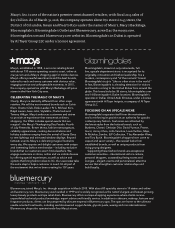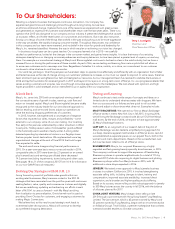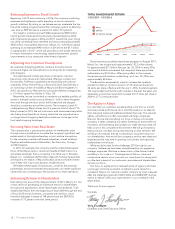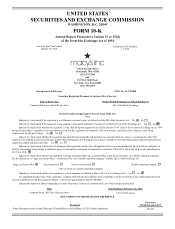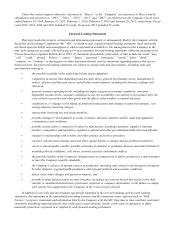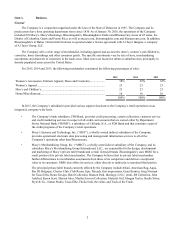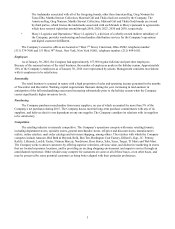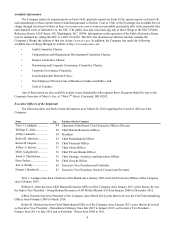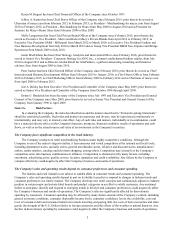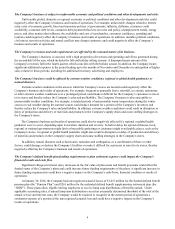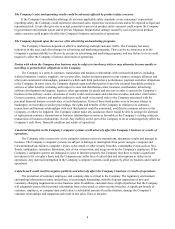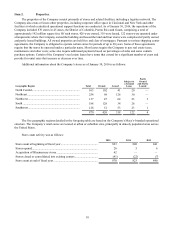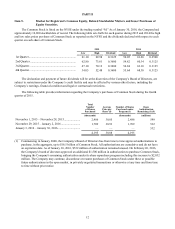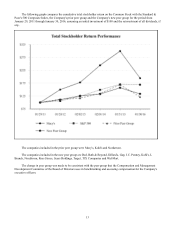Macy's 2015 Annual Report Download - page 11
Download and view the complete annual report
Please find page 11 of the 2015 Macy's annual report below. You can navigate through the pages in the report by either clicking on the pages listed below, or by using the keyword search tool below to find specific information within the annual report.6
The Company’s business is subject to unfavorable economic and political conditions and other developments and risks.
Unfavorable global, domestic or regional economic or political conditions and other developments and risks could
negatively affect the Company’s business and results of operations. For example, unfavorable changes related to interest
rates, rates of economic growth, fiscal and monetary policies of governments, inflation, deflation, consumer credit
availability, consumer debt levels, consumer debt payment behaviors, tax rates and policy, unemployment trends, energy
prices, and other matters that influence the availability and cost of merchandise, consumer confidence, spending and
tourism could negatively affect the Company’s business and results of operations. In addition, unstable political conditions,
civil unrest, terrorist activities and armed conflicts may disrupt commerce and could negatively affect the Company’s
business and results of operations.
The Company’s revenues and cash requirements are affected by the seasonal nature of its business.
The Company’s business is seasonal, with a high proportion of revenues and operating cash flows generated during
the second half of the year, which includes the fall and holiday selling seasons. A disproportionate amount of the
Company's revenues fall in the fourth quarter, which coincides with the holiday season. In addition, the Company incurs
significant additional expenses in the period leading up to the months of November and December in anticipation of higher
sales volume in those periods, including for additional inventory, advertising and employees.
The Company’s business could be affected by extreme weather conditions, regional or global health pandemics or
natural disasters.
Extreme weather conditions in the areas in which the Company’s stores are located could negatively affect the
Company’s business and results of operations. For example, frequent or unusually heavy snowfall, ice storms, rainstorms
or other extreme weather conditions over a prolonged period could make it difficult for the Company’s customers to travel
to its stores and thereby reduce the Company’s sales and profitability. The Company’s business is also susceptible to
unseasonable weather conditions. For example, extended periods of unseasonably warm temperatures during the winter
season or cool weather during the summer season could reduce demand for a portion of the Company’s inventory and
thereby reduce the Company's sales and profitability. In addition, extreme weather conditions could result in disruption or
delay of production and delivery of materials and products in the Company's supply chain and cause staffing shortages in
the Company's stores.
The Company's business and results of operations could also be negatively affected if a regional or global health
pandemic were to occur, depending upon its location, duration and severity. To halt or delay the spread of disease, local,
regional or national governments might limit or ban public gatherings or customers might avoid public places, such as the
Company's stores. A regional or global health pandemic might also result in disruption or delay of production and delivery
of materials and products in the Company's supply chain and cause staffing shortages in the Company's stores.
In addition, natural disasters such as hurricanes, tornadoes and earthquakes, or a combination of these or other
factors, could damage or destroy the Company’s facilities or make it difficult for customers to travel to its stores, thereby
negatively affecting the Company’s business and results of operations.
The Company’s defined benefit plan funding requirements or plan settlement expense could impact the Company’s
financial results and cash flow.
Significant changes in interest rates, decreases in the fair value of plan assets and benefit payments could affect the
funded status of the Company’s plans and could increase future funding requirements of the plans. A significant increase in
future funding requirements could have a negative impact on the Company’s cash flows, financial condition or results of
operations.
At January 30, 2016, the Company had unrecognized actuarial losses of $1,451 million for the funded defined benefit
pension plan (the “Pension Plan”) and $261 million for the unfunded defined benefit supplementary retirement plan (the
“SERP”). These plans allow eligible retiring employees to receive lump sum distributions of benefits earned. Under
applicable accounting rules, if annual lump sum distributions exceed an actuarially determined threshold of the total of the
annual service and interest costs, the Company would be required to recognize in the current period of operations a
settlement expense of a portion of the unrecognized actuarial loss and could have a negative impact on the Company’s
results of operations.


